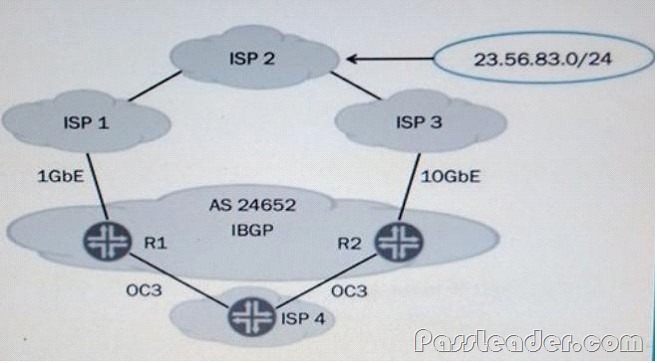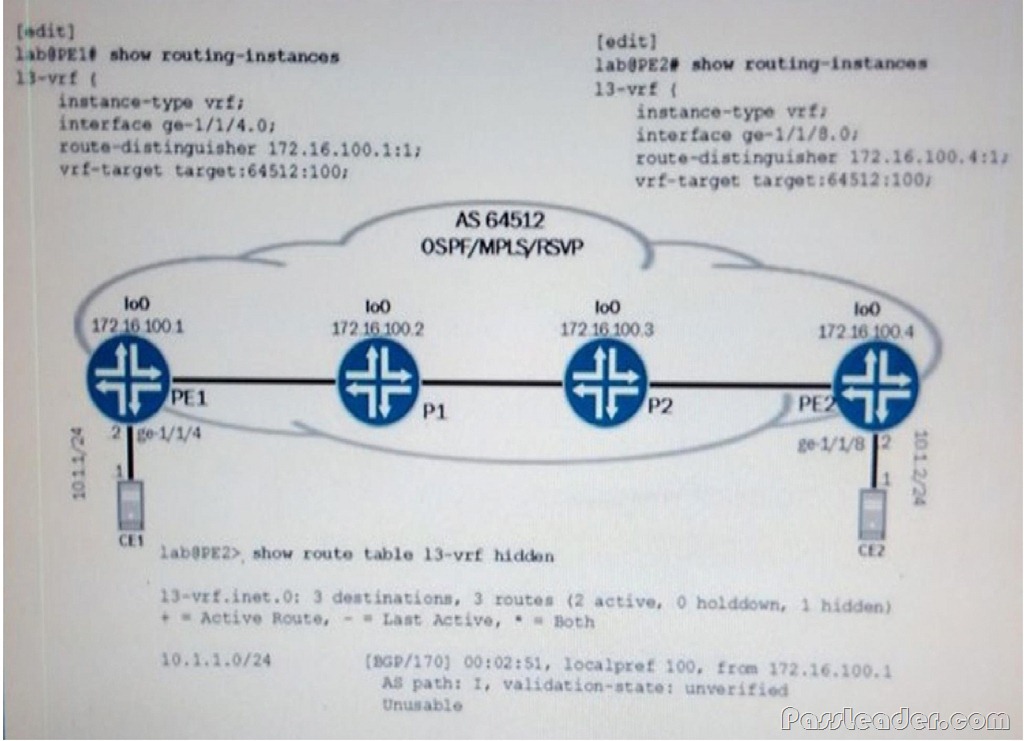The newest Juniper JN0-661 dumps are available from PassLeader, you can get both JN0-661 VCE dumps and JN0-661 PDF dumps from PassLeader! PassLeader have added the newest JN0-661 exam questions into its JN0-661 VCE and PDF dumps now, the new JN0-661 braindumps will help you 100% passing the JNCIP-SP JN0-661 exam. Welcome to download the valid PassLeader JN0-661 dumps VCE and PDF here: https://www.passleader.com/jn0-661.html (138 Q&As Dumps)
Besides, download that PassLeader JN0-661 braindumps from Google Drive: https://drive.google.com/open?id=0B-ob6L_QjGLpUmhnOVlfdm5YMjQ (FREE VERSION!!!)
QUESTION 11
Packets traverse a Junos device configured for class of service. Which two statements are true in this scenario? (Choose two.)
A. Packets are subject to traffic shapers before policers.
B. Packets are subject to policers before traffic shapers.
C. Packets are processed by behavior aggregate classifiers before multifield classifiers.
D. Packets are processed by multifield classifier before behavior aggregate classifiers.
Answer: AC
Explanation:
A: Traffic shaping and policing can work in tandem. For example, a good traffic shaping scheme should make it easy for nodes inside the network to detect misbehaving flows. This activity is sometimes called policing the traffic of the flow.
C: The simplest way to classify a packet is to use behavior aggregate (BA) classification. For a specified interface, you can configure both a multifield classifier and a BA classifier without conflicts. Because the classifiers are always applied in sequential order, the BA classifier followed by the multifield classifier, any BA classification result is overridden by a multifield classifier if they conflict.
http://www.juniper.net/techpubs/en_US/junos15.1/topics/concept/classifier-ba-overview-cos-config-guide.html
QUESTION 12
You are using PIM-SM in your network and want to ensure that all available equal-cost paths are being used for multicast traffic.

Referring to the exhibit, where must you configure the PIM join-load-balance parameter to achieve this goal?
A. R2, R4, and R5
B. R1, R2, R4, and R5
C. R4
D. R4 and R5
Answer: D
Explanation:
Incorrect:
A, B: R2 is the RP. You configure PIM join load balancing on the non-RP routers in the PIM domain.
http://www.juniper.net/documentation/en_US/junos15.1/topics/task/configuration/mcast-pim-join-load-balance.html
QUESTION 13
You have configured an OSPF stub area. The routes in the stub area require external reachability. Which statement explains how OSPF meets this requirement?
A. The ABR will generate a 0.0.0.0/0 martian route in the area.
B. The ABR will flood Type 5 LSAs into the area.
C. The ABR will flood Type 7 LSAs into the area.
D. The ABR will generate a 0.0.0.0/0 default route in the area.
Answer: D
Explanation:
Reachability for routes external to OSPF is achieved via a 0/0 default route injected by the ABR.
https://forums.juniper.net/jnet/attachments/jnet/Learning/58/2/AJNR_Module02_OSPF-Stub_5-1-0_Alpha.ppt
QUESTION 14
Which two statements are associated with any-source multicast? (Choose two.)
A. Routes learn the source of the multicast traffic from the source address of the multicast traffic.
B. Routes learn the source of the multicast traffic from the receives.
C. Routes do not specify a specific source from which to receive traffic.
D. Receives select a specific source from which to receive traffic.
Answer: AC
Explanation:
An any-source multicast (ASM) network must be able to determine the locations of all sources for a particular multicast group whenever there are interested listeners, no matter where the sources might be located in the network. In ASM, the key function of source discovery is a required function of the network itself. Multicast source discovery appears to be an easy process, but in sparse mode it is not. In dense mode, it is simple enough to flood traffic to every router in the network so that every router learns the source address of the content for that multicast group.
https://www.juniper.net/documentation/en_US/junos13.3/topics/topic-map/mcast-mvpns-draft-rosen-6.html
QUESTION 15
In a carrier-of-carrier VPN model, which type of network layer reachability information is used for the MP-BGP signaling between CE and PE routers?
A. inet-vpn
B. flow
C. labeled-unicast
D. unicast
Answer: A
Explanation:
In a Carrier-of-Carrier VPN environment, specify the inet-vpn address family and unicast traffic type to enable BGP to carry IPv4 network layer reachability information (NLRI) for VPN routes.
http://www.juniper.net/documentation/en_US/junos15.1/topics/example/mpls-vpn-option2-configuration.html
QUESTION 16
To reduce the size of OSPF Area 100, you configure the area with the no-summaries parameter. After committing this configuration change, you notice that an OSPF router in a remote area is no longer receiving Type 5 LSAs from an ASBR in Area 100. Which statement is true in this scenario?
A. The ASBR in Area 100 generates Type 5 LSAs, and they are blocked by the ABR.
B. The ASBR in Area 100 generates Type 5 LSAs, and a virtual link is required for transport to other areas.
C. The ASBR in Area 100 generates Type 5 LSAs, and they are transported to Type 7 LSAs.
D. The ASBR in Area 100 generates Type 5 LSAs, and places them in its own database.
Answer: A
Explanation:
The no-summaries setting prevents the ABR from advertising summary routes into the NSSA.
http://www.juniper.net/documentation/en_US/junos16.1/topics/example/ospf-not-so-stubby-area-configuring.html
QUESTION 17
Referring to the exhibit, you control AS 24652. You are asked to ensure that traffic destined to the 23.56.83.0/24 network from ISP 4 takes the most optimum path through ISP 3. ISP 1 should be used as a backup for this traffic flow.

Which two actions would accomplish this task? (Choose two.)
A. Set a higher local preference for the route advertised by ISP 3.
B. Advertise a longer AS path from R2 to ISP 4.
C. Set a lower local preference for the route advertised by ISP 3.
D. Advertise a longer AS path from R1 to ISP 4.
Answer: AD
Explanation:
A: Internal BGP (IBGP) sessions use a metric called the local preference, which is carried in IBGP update packets in the path attribute LOCAL_PREF. When an autonomous system (AS) has multiple routes to another AS, the local preference indicates the degree of preference for one route over the other routes. The route with the highest local preference value is preferred.
D: BGP does not take bandwidth into consideration when determining the best path. By using AS path prepending, you can lengthen the AS path that routing devices advertise to neighbors to make the neighbors calculate the path to be longer than it actually is.
https://www.juniper.net/documentation/en_US/junos15.1/topics/topic-map/bgp-local-preference.html
http://www.juniper.net/documentation/en_US/junos15.1/topics/example/routing-policy-security-routing-policy-to-prepend-to-as-path-configuring.html
QUESTION 18
An L2VPN (draft-kompella-mpls-l2vpn) is established between two PE routers to provide connectivity between two customer sites. Which two statements related to this deployment are true? (Choose two.)
A. BGP must be used for the control plane communications.
B. Kompella encapsulation is used in the data plane communications.
C. LDP must be used for the control plane communications.
D. Martini encapsulation is used in the data plane communications.
Answer: AB
Explanation:
Junos OS substantially supports RFC 4447, Pseudowire Setup and Maintenance Using the Label Distribution Protocol (LDP). Martini uses directed LDP to signal the VPN label between the PE devices, Kompella uses BGP to signal the VPN label between the PE devices.
https://www.juniper.net/documentation/en_US/junos15.1/topics/reference/standards/layer-2-circuit.html
QUESTION 19
The exhibit shows the partial configurations of PE1 and PE2. PE2 is unable to forward VPN data to PE1.

What should be configured to solve this problem?
A. Configure an MPLS LSP from PE2 to PE1.
B. Configure a route on PE2 to PE1’s loopback address in inet 0.
C. Configure a matching vrf-target statement on PE1 and PE2.
D. Configure a static default route in inet 3 on PE2.
Answer: A
Explanation:
http://forums.juniper.net/t5/Routing/VPLS-MPLS-TE-problem/td-p/259975
QUESTION 20
What are two characteristics of L2 circuits? (Choose two.)
A. Routing instance configuration is required for L2 circuits to function correctly.
B. Routing instance configuration is not required for L2 circuits to function correctly.
C. BGP is required for L2 circuits to function correctly.
D. BGP is not required for L2 circuits to function correctly.
Answer: BD
Explanation:
B: You configure Layer 2 VPNs in a routing instance. As a result, Layer 2 VPNs have unique site and VPN identifiers. However, Layer 2 circuits do not require a routing instance configuration and instead use an alternate method of identifying circuits.
D: Layer 2 VPNs, like Layer 3 VPNs, require Border Gateway Protocol (BGP) for transport of traffic between PE routers. In contrast, Layer 2 circuits do not require BGP. Instead, Layer 2 circuits rely on LDP and MPLS for their operation.
http://www.juniper.net/techpubs/en_US/junos12.3/topics/concept/layer-two-circuits-overview-solutions.html
Thanks for reading the newest JN0-661 exam dumps! We recommend you to try the PREMIUM PassLeader JN0-661 dumps in VCE and PDF here: https://www.passleader.com/jn0-661.html (138 Q&As Dumps)
Also, you can download that PassLeader JN0-661 braindumps from Google Drive: https://drive.google.com/open?id=0B-ob6L_QjGLpUmhnOVlfdm5YMjQ (FREE VERSION!!!)
